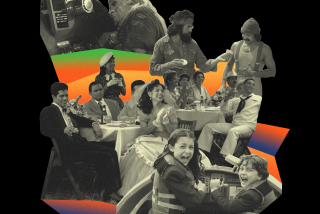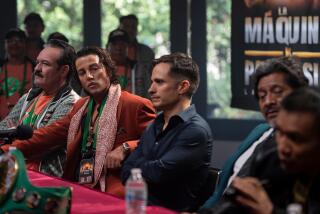TV for kids courts Spanish speakers
NEW YORK — Each episode of “Dora the Explorer” starts with the animated heroine dashing from her family’s hacienda, waving to her Mami and Papi and scooting off into the jungle.
“Ready to explore?” asks the brave and curious 7-year-old. “Vamos arriba!”
Just about everyone in Dora’s world speaks fluent English and Spanish, their adventures are punctuated by salsa rhythms -- and young TV viewers can’t get enough of the mix. Her Nickelodeon show was the top-rated preschool program for four years, and when she was finally dethroned a few months ago, it was by a new spin-off featuring her cousin, Diego.
If you’re looking for television that spotlights Latino characters and themes, don’t bother with prime time -- those shows mostly ignore the nation’s largest ethnic group.
Hoy, los programas de Latino son los que los ninos estan mirando. (Today, Latino programs are the ones children are watching.)
“These programs are making diversity a natural part of kids’ understanding of the world around them,” said Phillip C. Serrato, a professor of children’s literature at Cal State San Diego.
Multicultural children’s TV used to start -- and mostly end -- with PBS’ “Sesame Street.” For 37 years, the ensemble show has been a United Nations of characters.
But now PBS Kids’ has more Latino offerings. “Dragon Tales” was revamped last year to highlight Latino issues and include Enrique, an immigrant who is Puerto Rican and Colombian. “Jay Jay the Jet Plane” added a new bilingual plane named Lina. PBS Kids Go!, a 24-hour cable station to launch this fall, will include two hours a day of shows in Spanish with English subtitles.
The Disney Channel will debut “Handy Manny,” a preschool cartoon centered on a bilingual Manny Garcia and talking tools, later this year. The Cartoon Network, meanwhile, has “Mucha Lucha,” a Mexican wrestling cartoon, while the animated “Maya & Miguel” is produced by Scholastic Entertainment and aimed at Spanish-speaking kids just starting school.
“All the characters are bilingual to varying degrees,” said Deborah Forte, Scholastic’s president. “Abuela [Grandma] Elena speaks Spanish. The kids speak much more English, especially out in the streets, but they pepper it with Spanish. We studied the way families spoke, and this was the way many of them did it.”
What’s driving the trend? Producers say it’s demographics.
The census for 2000 showed that Latino communities are the nation’s fastest growing -- and that the biggest five-year Latino age group is infants to preschoolers.
More to Read
Sign up for The Wild
We’ll help you find the best places to hike, bike and run, as well as the perfect silent spots for meditation and yoga.
You may occasionally receive promotional content from the Los Angeles Times.






